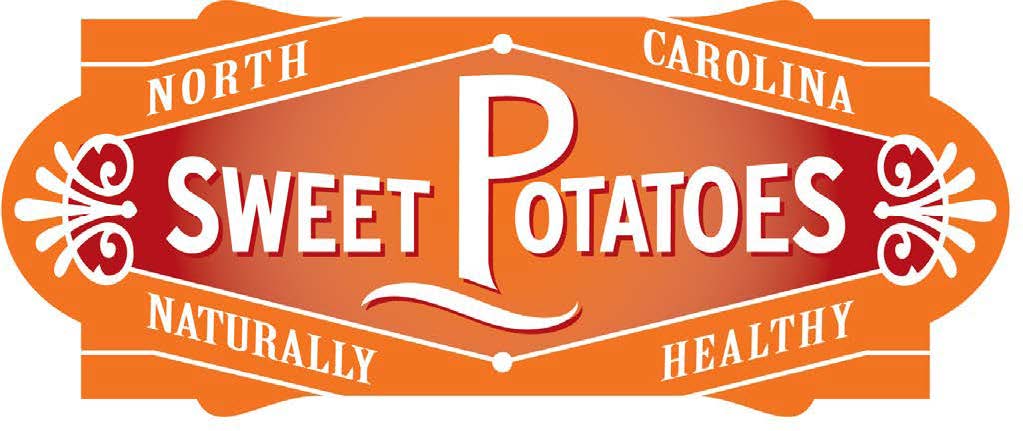Overview
Purpose
Students will understand the cell structure and function by investigating the sweetpotato life cycle. Students will understand how the processes of photosynthesis, environmental factors, and biotechnology determine the success of sweetpotato production in North Carolina.
Subject Areas
Biology
Essential Questions
- What is the difference between a prokaryotic and eukaryotic cell?
- What is the life cycle and cell cycle of a sweetpotato?
- How does photosynthesis play an important part of the sweetpotato’s life cycle?
- What is agricultural biotechnology?
- What are GMO crops?
Materials
- From Farm to School – Crops of North Carolina: Digging for Sweetpotatoes by Heather Barnes and Karen Baltimore (book)
Printed by North Carolina Department of Agriculture and Consumer Services
Publication supported by U.S. Department of Agriculture’s (USDA) Agriculture Marketing Service North Carolina - Technology: Computer/iPad/Chromebook, etc.
- Chart paper
- Markers
- Sweetpotatoes (talk with a local sweetpotato farmer)
- Mason jar/plastic cup
- Water
- Soil types: clay, sand, dirt
- Toothpicks (5-6 student)
- What is a GMO? Infographic found at https://gmoanswers.com/
Essential Files/Links
- From Farm to School – Crops of North Carolina: Digging for Sweetpotatoes (book)
- Diffusion & Active Transport Interactive Note Taking Sheet
- Parts of a Microscope
- Microscope Drawing Handout
- Cell Cycle Mitosis Interactive Note Taking Sheet and Microscope Lab
- Simple Cell Diagram
- Animal and Plant Cell Diagram
- Life Cycle of a Sweetpotato
- The Carbon Cycle Diagram
- https://gmoanswers.com/
- https://www.khanacademy.org/science/high-school-biology/hs-cells/hs-prokaryotes-and-eukaryotes/v/prokaryotic-and-eukaryotic-cells
Vocabulary
Abiotic factors: non-living parts of an ecosystem. Examples include sunlight, wind, clouds, water, rocks, energy, temperature, and soil.
Active Transport: the movement of substance across a biological membrane against its concentration gradient; from a less-concentrated area to a more-concentrated area. Active transport requires the input of energy and uses specific transport proteins.
ATP: adenosine triphosphate; a compound that has three phosphate groups and is used by cells to store energy.
Agriculture: the science or practice of farming, including cultivation of the soil for the growing of crops and raising animals to provide food, wool, and other products.
Agricultural Biotechnology: scientific techniques used to improve plants, animals, and microorganisms.
Biotechnology: technology used on the basis of biological processes such as plant breeding.
Cells: smallest unit of life for the structural, functional, and biological unit of all living organisms – plants, animals, and humans.
Chlorophyll: a green pigment, present in all green plants and in cyanobacteria, responsible for the absorption of light to provide energy for photosynthesis.
Chloroplasts: plastids in green plant cells which contains chlorophyll. Photosynthesis takes place wthin the chloroplasts.
Commodities: a raw material or an agricultural product that can be bought and sold such as a sweetpotato.
Concentration Gradient: a difference in the concentration of certain molecules over a distance. Diffusion: the movement of a substance down its concentration gradient from a more-concentrated area to a less-concentrated area.
DNA: deoxyribonucleic acid, a molecule that carries the genetic instructions used in the growth, development, function, and reproduction of all known living organisms.
Eukaryotic: cells that have nucleus surrounded by a nuclear membrane and also contain cell organelles.
Fibrous Roots: thin, branching, shallow roots growing from the stem that collect water for plant growth.
Flower: part of the plant for reproduction that can produce seeds.
Genes: a unit of heredity found in cells transferred from a parent to offspring that determines characteristics of the offspring.
Genetic modification: process of changing the gene structure of a living thing to make it healthier, stronger, or more useful to humans.
Genetically Modified Organism: also known as GMO, is the result of transferring desirable traits found in nature to other plants and organisms as a way to improve that plant or organism’s growth, yield, pest resistance, etc. (see Transgenic organism).
Hydrogen: a colorless, highly flammable gas with an atomic number of 1.
Leaf: part of the plant that uses energy from sunlight for photosynthesis.
Natural resources: materials or substances such as minerals, forests, water, and fertile land that occur in nature and can be used for economic gain.
Nodes: part of a plant stem where one or more leaves will emerge.
Oxygen: a colorless, odorless reactive gas, and the life supporting component of air with an atomic number of 8.
Photosynthesis: process where green plants and some other organisms take sunlight to synthesis foods from carbon dioxide and water. It takes place in the leaves of plants.
Plant Breeding: a scientific technique used to combine two sexually compatible sub-species to create a plant variety with desired traits from the parent plants.
Prokaryotic: cells that do not have a true nucleus or most other cell organelles.
Slips: shoots that are grown from a mature sweetpotato.
Stem: the body or stalk of the plant.
Stomata: tiny pores found in the leaves of plants that open and close allowing the intake of carbon dioxide and the release of oxygen.
Storage Root or Tuber: roots that are specifically modified for storage of starch, water, and nutrients such as carrots and sweetpotatoes.
Transgenic Organism: an organism whose genome has been altered by the transfer of a gene or genes from another species or breed (genetically modified organism).
Transplanting: replanting in a different location.
NC Ag Facts
- North Carolina grows nearly 60% of all United States sweetpotatoes (more than any other state in the United States).1
- The sweetpotato is North Carolina’s state vegetable.1 The single-word term helps differentiate the sweetpotato from the white or Irish potato, which is a tuber, not a root, and possess a different nutrient profile. Sweetpotato –Ipomoea batatas, a storage root is part of the morning glory family.9
- North Carolina sweetpotatoes are available every month of the year.1
- Most sweetpotatoes are grown in the piedmont and coastal plain regions of North Carolina because of the well-drained, sandy soil.1
- There are hundreds of varieties of sweetpotatoes and many are grown across North Carolina. Some you may see most often in grocery stores include the Japanese sweetpotato, the White sweetpotato, and the Covington sweetpotato.1
- In 2017, nearly 89,500 acres of sweetpotatoes were harvested; 30,000 more acres than California, Louisiana and Mississippi combined.8
- North Carolina has produced more than one billion pounds of sweetpotatoes for the last seven years; this is the only state to exceed one billion pounds.8
- In dollars, NC had the largest increase in 2017 at just over $37 million.8
Background Knowledge
Did you know that a sweetpotato is actually part of the morning glory family? It is a perennial (perennials regrow every spring); though it is cultivated as an annual (annuals live for one growing season, but often cannot be overwintered). The creeping stems of this amazing plant can grow up to 20 feet long and frequently send out roots at the nodes which, in favorable seasons, bear small potatoes.
There are three main types of leaves: round, shouldered, and lobed or split. The color of the stems and leaves varies from dark green to light purple. No flowers are produced except in southern latitudes.2
The skin color of a sweetpotato can range from white to yellow, red, purple, or brown. The flesh also ranges in color from white to yellow, orange, or orange-red.3
So, is it a yam, a sweetpotato, or are they the same thing? The truth: yams and sweetpotatoes are not the same thing at all. There are thousands of sweetpotato varieties. Sweetpotato varieties are classified as either ‘firm’ or ‘soft’ – firm varieties were produced before soft varieties. When the soft varieties were grown there was a need to differentiate between the two (firm or soft). Africans actually named the ‘soft’ sweetpotatoes ‘yams’ because they resembled the yams in Africa. Their native word was ‘nyami’ and if the n & i are removed the term ‘yam’ remains. Despite this identification, this is not true. In fact, while the ‘soft’ varieties look like yams, they are not yams at all; it is just a variety of sweetpotato.
Yams are often imported from the Caribbean; they are rough and scaly—very different from our smooth, orange flesh variety sold in the United States. In the United States, people often use the word sweetpotatoes and yams interchangeably; however, this is not correct and often adds confusion for the consumer. When a consumer goes to the store and purchases ‘yams,’ they are more than likely purchasing a different variety of sweetpotato. Today, the U.S. Department of Agriculture requires labels with the term ‘yam’ to be accompanied by the term ‘sweetpotato.’3
According to the North Carolina SweetPotato Commission, North Carolina has ranked number one in sweetpotato production in the United States since 1971 (2018). North Carolina’s hot, moist climate and rich, fertile soil are ideal for cultivating sweetpotatoes. Sweetpotato production in North Carolina averages nearly 60% of the U.S. supply.4
Climate
Sweetpotatoes can be grown where there is a long frost-free period with warm temperatures in the growing season.4 Most cultivars require a minimum frost-free period of 90-120 days, with a minimum average daily temperature of 77 degrees Fahrenheit. Sweetpotatoes also require an inch of water per week uniformly distributed throughout the growing season for highest yields.4
Uses for Sweetpotatoes
Sweetpotatoes have many uses. They can be prepared in a number of dishes, canned, preserved and dried. For drying, clean washed potatoes are placed in a suitable basket and immersed in boiling water for a short time; when taken out of the basket, they are cut into thin slices and spread over mats and exposed to the sun for two or three days. In order to make a superior quality, the skin of the potato is peeled off before slicing. Instances were reported wherein the dried product was successfully ground into flour.2 In North Carolina a company named Glean produces a sweetpotato flour.5 Sweetpotatoes can also be used as food stock for animals. They have been successfully fed to hogs, cattle, horses and poultry. 2
Student Motivator
Explain to students the next few weeks the theme of their science lessons will be based on an agriculture commodity that is very important to North Carolina. Actually, North Carolina produces 40% of the world’s supply of this commodity and nearly 60% of the United States supply. Play Kahoot and pose different facts about this agriculture commodity for students to identify as the sweetpotato. Questions can be created from the NC Ag Facts and Background Information sections of this lesson plan.
How to Play KAHOOT!
Let’s play KAHOOT! If you do not have an account set up, please follow the link here: https://create.kahoot.it/register to register. Once you have registered you may begin creating an interactive game for your students to learn and enjoy. Log into KAHOOT and simply click discussion, survey, multiple choice, or jumble to start making a quiz. Then you will add your questions using the NC Ag Facts and Background Knowledge sections of the lesson plan. Once you have created your Kahoot game, launch the game so players can join. A unique game pin will be provided and players will enter this pin to join. Remember this link: https://kahoot.com/ to be put in the browser of your device (computer, phone, iPad, tablet, etc.) to join the game. Kahoot can be used in many ways to ignite learning in your classroom.
Procedures
Activity 1: Cells & Organelles
Objectives Covered: Bio 1.1, Bio 1.1.1, Bio. 1.1.2, Bio. 1.2
- This lesson could be completed after a unit on prokaryotic and eukaryotic cells. Below is a link containing a video that explains the difference between the two cells.
- https://www.khanacademy.org/science/high-school-biology/hs-cells/hs-prokaryotes-and-eukaryotes/v/prokaryotic-and-eukaryotic-cells
- After viewing the video say to students, “We know that cells are the building blocks of all living things—both plant and animal. They make up all of the systems that carry out important functions to sustain life such as digestion and respiration. Cells are made up of genes that carry information to determine what living things look like and how they function.” Say, “We have briefly discussed the difference between prokaryotic and eukaryotic cells. We are now going to apply this knowledge.”
- In a class discussion, ask students, “If human body systems are made up of cells for conducting voluntary and involuntary functions, what do cells need in order to perform their job? Can they perform adequately if their needs are not met? Do humans contain prokaryotic or eukaryotic cells, or both? Do they demand different conditions or needs for survival?”
- Next, explain to the students or end the discussion with these facts:
- Human cells use nutrients from foods we eat to feed our cells for survival.
- Although humans are made up of eukaryotic cells there are many other living things made up of prokaryotic cells such as plants.
- Plants and animals originate from Cells make up all living things.
- Sweetpotatoes (hold up a sweetpotato) are made up of cells because it’s the edible product or storage root from the sweetpotato plant. It contains many of the nutrients human cells need for survival such as vitamins A and C, beta-carotene, thiamin, niacin, riboflavin, vitamins B5 and B6.
- Show students a picture of a Simple Cell Diagram (see image below and in the Essential Files). Ask students: “What comes to mind when you see this picture?” Say: “The picture you see is of simple cells, did you know that each one of us, as well as all plants and animals around us and all over the world are made up of cells.”

- Show a picture of a human cell (see image below) or draw it out on chart An Animal and Plant Cell Diagram is also available for students to examine (see Essential Files).
- Ask students the following questions to continue discussion: “What does a cell do? Cells have energy stored inside of them. Where does the energy come from? It comes from the foods we eat.” Ask students: “Is this a prokaryote or a eukaryote?” Answer: eukaryote
Human/Animal Cell:
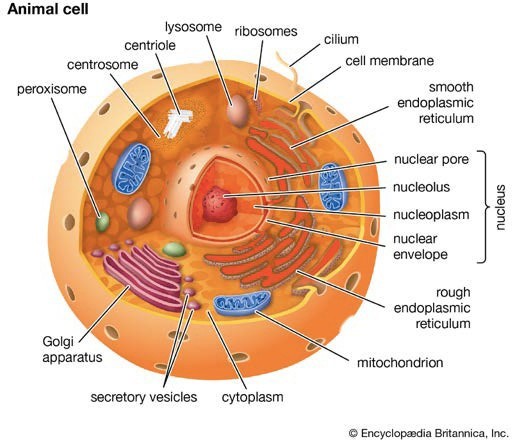
Photo retrieved from: https://www.britannica.com/science/cell-biology/media/1/101396/112877
- Show students a picture of a plant cell (see image below) or display the Animal and Plant Cell Diagram (see Essential Files). Plants also have cells – the plant cells tell how to build a plant. Ask students: “What do you see that is different about the plant cell?” Students should notice that the plants cells are square, etc. Ask students: “Is this a prokaryote or a eukaryote cell?” Answer: prokaryote
Plant Cell:
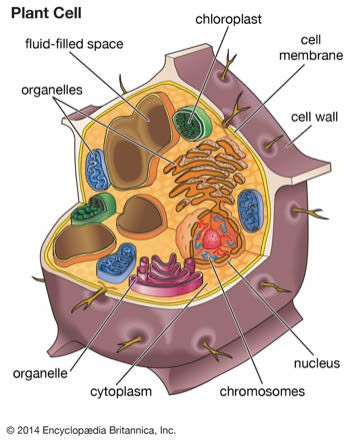
Photo retrieved from: https://www.britannica.com/science/cell-biology/media/1/101396/107000
- Show pictures of plant cells and human cells. Allow students to see different live/still pictures of Say, “Now that we have a good understanding of prokaryotic and eukaryotic cells let’s continue our learning by comparing the cells that make up this sweetpotato (plant) and the cells that make up the human body (animal).”
- Project – What is a Prokaryotic and Eukaryotic Cell? Put students into groups of 4-5 each and have them draw and label both a plant and animal/human cell. Students should identify the Prokaryotic (unicellular) and Eukaryotic cell.
During the Cell Project students should:
- Explain how the structure of the organelle determines its function. (Example: folded inner membrane in mitochondria increases surface area for energy production during aerobic cellular respiration).
- Summarize how these organelles interact to carry out functions such as energy production and use, transport of molecules, disposal of waste, and synthesis of new molecules. (Example: DNA codes for proteins which are assembled by the ribosomes and used as enzymes for energy production at the mitochondria).
Activity 2: Life Cycle of a SweetPotato
Objectives covered: Bio.1.2.1
- In this activity students will compare the mechanisms of active vs. passive transport (diffusion and osmosis).
- Students will conclude how the plasma membrane structure functions and explain changes in osmotic pressure that occurs when cells are placed in solutions of differing concentrations.
- Say: “We have a good understanding of the structure and function of cells. Today, we are going to actually see this take place in the process of growing and transplanting sweetpotatoes.”
- Begin lesson by explaining the process of active transport and diffusion. Have students discuss and write down the meaning of the following terms in their own words: ATP, active transport, concentration gradient, and diffusion – (see Vocabulary section) for scientific-based definitions. Make comparisons between the students’ definitions and those scientifically-based.
- Watch the video to expand understanding of active and passive transport. Video Link: https://www.khanacademy.org/science/high-school-biology/hs-energy-and-transport/hs-passive- and-active-transport/v/introduction-to-passive-and-active-transport
- When discussing the process of diffusion and active transport remind students that plants get their nutrients from the soil and pockets of air spaces filled with water, many nutrients in the soil are dissolved and suspended in the water. So how does the sweetpotato plant get these nutrients it needs? Answer: The plants root system.
- Explain the roles of diffusion and active transport in moving nutrients from the soil to the plant. Provide students with a Diffusion and Active Transport Interactive Note Taking Sheet (see Essential Files).
- Show students the chart of a plant and its root system (see image below). As students are examining the photo have them notice each of the parts and explain their roles.
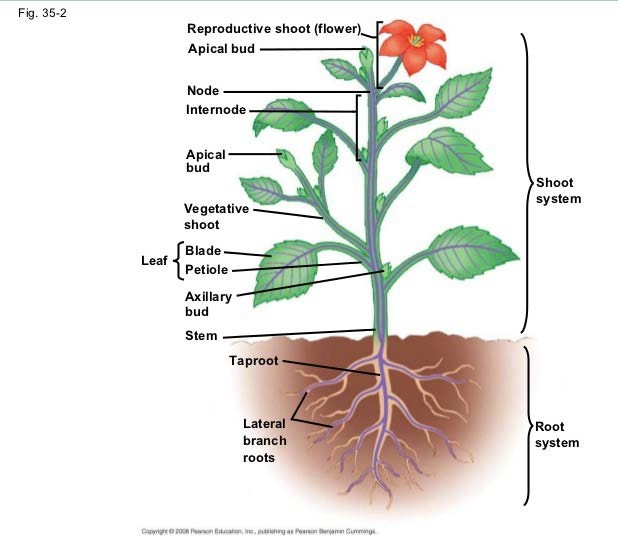
Image retrieved from: https://slideplayer.com/slide/8987227/
- Show students the picture of a sweetpotato plant (see image below). As students are examining the photo have them notice each of the parts and explain their roles. Additionally, have students compare and contrast the similarities and differences between the plant and root vs. the sweetpotato.
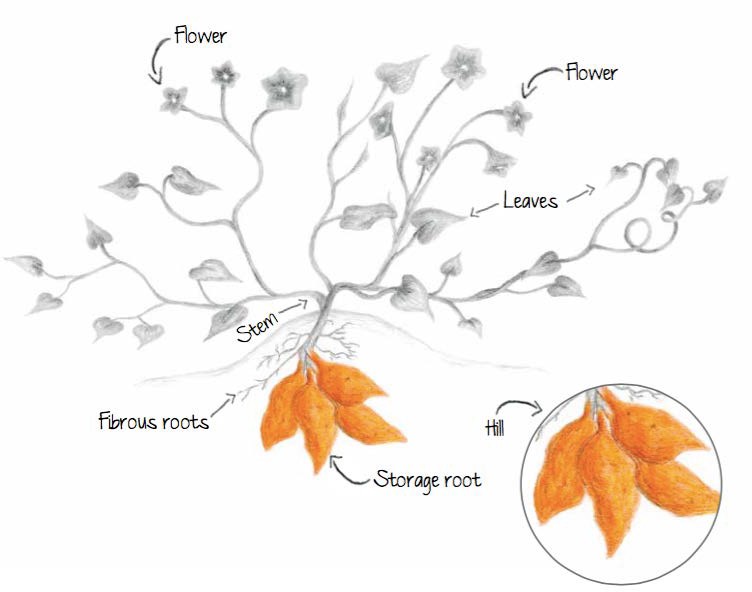
Photo credit: From Farm to School – Crops of North Carolina: Digging for Sweet Potatoes
- Provide each group of 4-5 students with a sweetpotato, plastic cup larger than the sweetpotato, and 5-6 toothpicks. Explain to students that they will be conducting observations of their sweetpotatoes and documenting their findings on their Diffusion and Active Transport Interactive Note Taking Sheet (see Essential Files).
- Allow each student in the group to carefully stick toothpicks mid-way into the widest portion of the sweetpotato. The toothpicks should be equally spaced around the sweetpotato. Students will carefully place the sweetpotato into a plastic cup. Then, carefully pour water into the cup, allowing the water to touch just the bottom of the sweetpotato. Students will place the sweetpotato in a sunny spot in the classroom that is level and safe. Refer to the examples pictured below.
Growing Sweetpotatoes
Materials
Sweetpotato, tooth picks, and Large Mouth Mason jar or plastic cup – depending on the size of the sweetpotato you may need something more substantial to hold it up.
Make sure to fill the jar or cup up as close to the top as possible, you can see that half of the sweetpotato is submerged in water. You do not have to add water daily, just when it starts to drop down below the sweetpotato add more so that it can get the hydration it needs. Also, if the water starts to smell or mold you may change it to fresh water.
Enjoy and have fun observing!
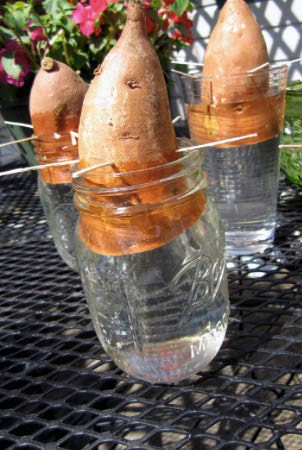
- Students will conduct initial observations and make an educated guess on what will happen in 2 days and in 2 weeks. Note: In approximately 4 weeks, sweetpotato sprouts will have reached about 8-10 inches tall and produce several leaves. At this point it is time for transplanting (replanting in a different location). Carefully remove the sprouts by giving them a twist or cutting them with knife/scissors (with teacher’s supervision). Allow each student to receive a sweetpotato sprout.
- Transplant the Have students make note of the soil type and test the pH of the soil before planting. As we have learned in earlier lessons, sweetpotatoes need to be grown in well-drained, sandy, loamy soil. Prepare the soil by tilling and applying fertilizer (Miracle-Gro will be sufficient). Plant the sprouts 9 to 10 inches apart in the center of a ridge row at a depth of about 3 inches with at least 2 plant nodes (part of plant that will become stem/leaf) underground and 2 or more leaves above ground. Plants will need water immediately after transplanting.
- Students will take notes about the process of the plant root system and how important a good root system is to the growth of sweetpotatoes and all plants alike. Additionally, have students to discuss the role of ATP, active transport, concentration gradients, and diffusion. The roles of each in the growth of a plant.
Activity 3: Under a Microscope
Objectives Covered: Bio 1.1.2, Bio. 1.2
- In this activity students will review the parts of a microscope and proper use of lab equipment.
- Students will actively engage in scientific exploration of plant cells (onion).
- Students will actively engage in scientific exploration of human cells (cheek).
- Students will compare the structure of prokaryotic and eukaryotic cells to conclude the following: Presence of membrane bound organelles: mitochondria, nucleus, vacuole, and chloroplasts are not present in prokaryotes.
- Most science classrooms are equipped with microscopes and materials to utilize a microscope. Please collect all materials prior to lesson.
- Begin by briefly covering the parts of a microscope, preview document Parts of a Microscope (see Essential Files).
- Say to students: “Today we are going to take a closer look at our cells and the difference between prokaryotic and eukaryotic cells.” Explain to students they are going to compare a human cell to a plant cell.
- Observation Project: Before the observation project, review the use and the parts of a light microscope. Next, explain to students they will be looking at their very own cells.
- Students should: Proficiently use proper light microscopic techniques as well as determine total power magnification.
- Students will complete the Human Cheek Cell Project. Follow the instructions on this website: https://www2.mrc-lmb.cam.ac.uk/microscopes4schools/humancheek.php **If you have premade microscope slides with different plant and animal cells please select to use these slides.
- Students will draw pictures of cheek cells in the Microscope Drawing Handout (see Essential Files).
- Now that students have completed their first observation of a human cheek cell, they will now look at a plant cell.
- Draw student’s attention to their growing sweetpotato sprouts. Explain that this next observation will help us better understand the structure of the plant cells.
- Students will complete Onion Cell Microscope Lab. Follow the instructions on this website: https://microscopy4kids.org/Red_Onion_Cells
- Students will draw pictures of onion cells in the Microscope Drawing Handout (see Essential Files).
- After both labs have been completed discuss with students their findings and drawings. Students should see that prokaryotic cells are less complex than eukaryotic cells. If they have not already done so, have them compare the structure of prokaryotic and eukaryotic cells to conclude the following: Presence of membrane bound organelles – mitochondria, nucleus, vacuole, and chloroplasts are not present in prokaryotes.
- Students will learn:
- Ribosomes are found in both.
- DNA and RNA are present in both but are not enclosed by a membrane in prokaryotes (human/animal cells).
- Contrasts in chromosome structure – circular DNA strands called plasmids are characteristic of prokaryotes (human/animal cell).
- Contrasts in size – prokaryotic (human/animal) cells are smaller.
- Students will learn:
- Finally, draw student’s attention to their growing sweetpotatoes once more. Ask students, “What can we infer about our sweetpotato plant?” “What types of cells make up a sweetpotato plant?”
Activity 4: The Cell Cycle & Mitosis
Objectives Covered: Bio.1.2, Bio.1.2.2
- During this activity students will outline the cell cycle – Growth1, Synthesis, Growth2, Mitosis, and Cytokinesis.
- Students will recognize mitosis as a part of asexual reproduction. (middle school review)
- Students will organize diagrams of mitotic phases and describe what is occurring throughout the process.
- Say: “Now that we have begun the process of growing and transplanting our sweetpotatoes, let’s look a bit deeper.” Understanding the process and function of cells helps scientists and farmers provide medicine to cure disease and grow an abundant amount of food on small land masses.
- Provide students with a Cell Cycle Mitosis Interactive Note Taking Sheet and Microscope Lab (see Essential Files).
- Show students The Cell Cycle Mitosis video
- After students have watched the video and taken adequate notes have them get into small groups. Students will work together utilizing technology or science textbooks (available in class or school library) to research the phases of growth in the cell cycle. Teacher should scaffold learning and address misconceptions as necessary (please see answer key to Cell Cycle Mitosis Note Sheet).
- After students have had adequate work time, allow them to share out their findings as a whole group (i.e. – students come up to smart board and fill in blank Cell Cycle Interactive Note Sheet or whole group discussion of notes).
- To close out the lesson pose this question to students: How do you think this process applies to the growth of our sweetpotato plants? (Use Exit Ticket with 3-2-1 protocol or other best practices to evaluate students learning and understanding).
- Exit Ticket: 3-2-1
- 3 things you learned about the process of the cell cycle
- 2 thoughts about the process associated to growing sweetpotatoes
- 1 question you still have about sweetpotatoes or its cell cycle
- Exit Ticket: 3-2-1
Activity 5: The Process of Photosynthesis
Objectives Covered: Bio.2.1, Bio.2.1.1
- During this activity students will deconstruct the carbon cycle as it relates to photosynthesis, cellular respiration, decomposition and climate change.
- Students will summarize the nitrogen cycle (including the role of nitrogen fixing bacteria) and its importance to synthesis of proteins and DNA.
- Students will identify factors that influence climate such as: greenhouse effect (relate to carbon cycle and human impact on atmospheric CO2).
- We all know cells are amazing, but plant cells are extremely unique because they make their own food utilizing abiotic factors and processes of the cell. Review abiotic factors (sunlight, soil, water, wind, clouds, rocks, energy, and temperature) with students.
- Pose the following questions to the students:
- How do plant cells work and grow?
- How does the abiotic process help the growth of sweetpotatoes?
- What do these plant cells need to survive?
- Say, “I am going to put a diagram on the board. Think for a minute what this is an example of.” Have students brainstorm with a partner by saying, “Turn and talk with a person sitting next to What does this image show us?” Students will say the process of growing sweetpotatoes, how to grow plants, cycle of growing potatoes, or life cycle. Provide the diagram, Life Cycle of a Sweetpotato to each student (see Essential Files).
- Say, “The life cycle of a sweetpotato is going to help us answer our previous questions.”
- Allow students to discuss what they observe from the life cycle diagram and answer the previous questions listed above.
Life Cycle of a Sweetpotato:
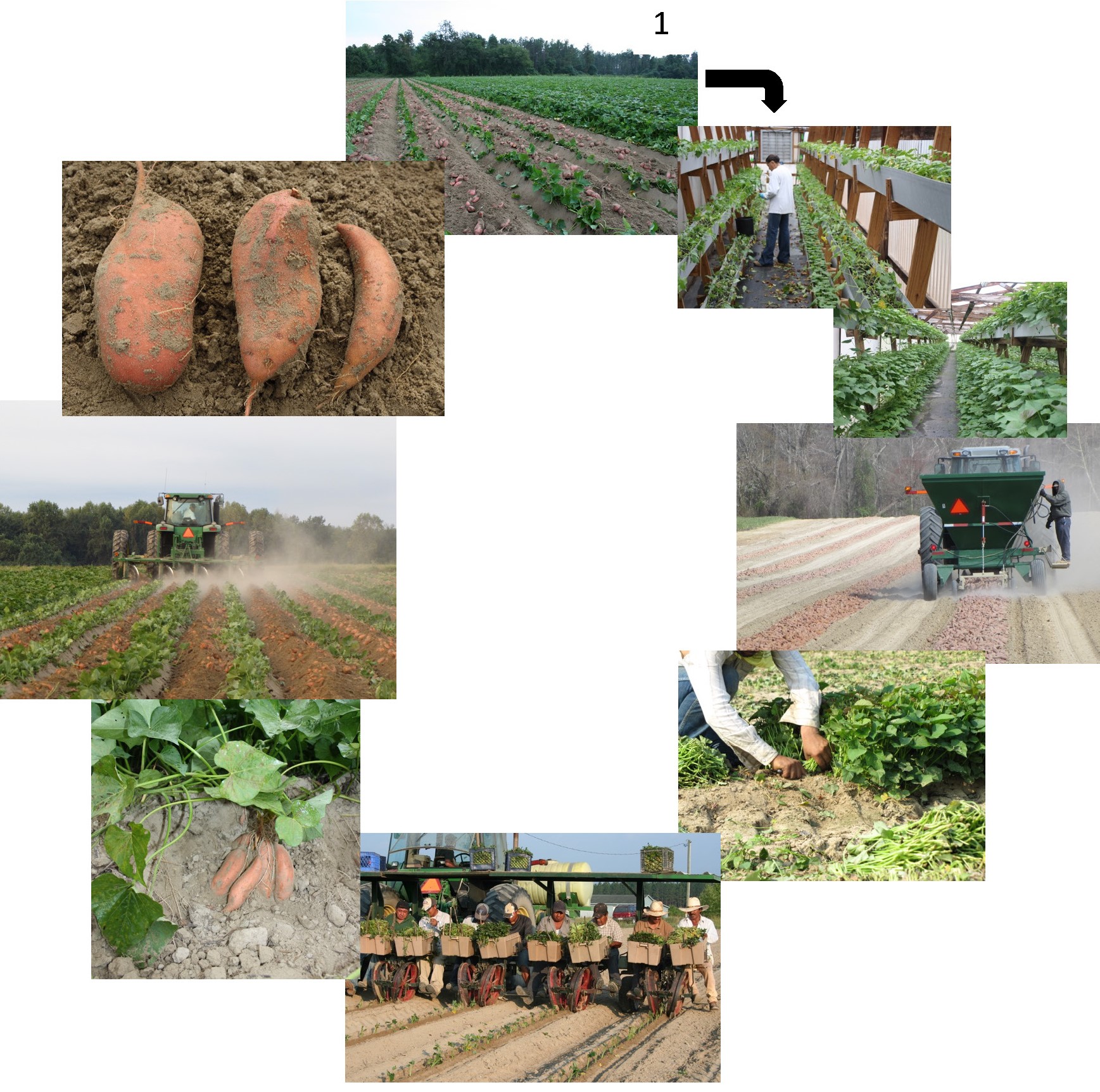
Information for deeper thinking: As the students view the images, they will begin to understand how sweetpotatoes are used to grow sprouts in order to grow more sweetpotatoes. Students will make note that sweetpotatoes grow under the ground and have green leaves and flowers above ground. Around August, farmers begin to harvest their crop. They use tractors and plows to lift up the soil so the sweetpotatoes can be dug up. Sweetpotatoes are grown for specialty dishes and are a healthy vegetable for us to eat. Farmers also feed parts of the sweetpotato plant and sweetpotatoes to livestock on their farms. After sweetpotatoes are sold to markets, the leftovers are used to grow sprouts, also known as slips, for growing new plants which begin the life cycle once again. This process can be a continuous cycle and it is important that the farmer monitors and manages the soil properly for quality and conservation management practices of the land.
- After students have discussed the life cycle of a sweetpotato, bring them back to the original questions:
- How do plant cells work and grow?
- How does the abiotic process help the growth of sweetpotatoes?
- What do these plant cells need to survive?
- How do plant cells work in the growth of a sweetpotato? Answer: Photosynthesis.
- Explain to students that photosynthesis is a word that can be broken down for us to understand. “Photo” means light and “Synthesis” means putting together. What is the process of photosynthesis and how does it work? Plants make their own food. In order for plants to make their own food they need the following: carbon dioxide, water, and sunlight.
- Post a picture or diagram that explains photosynthesis (see images below). Divide students into small groups (3-4 students in each).
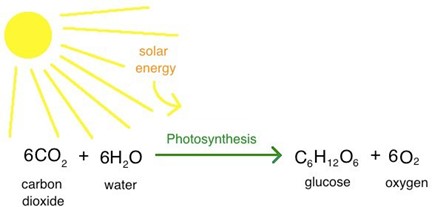
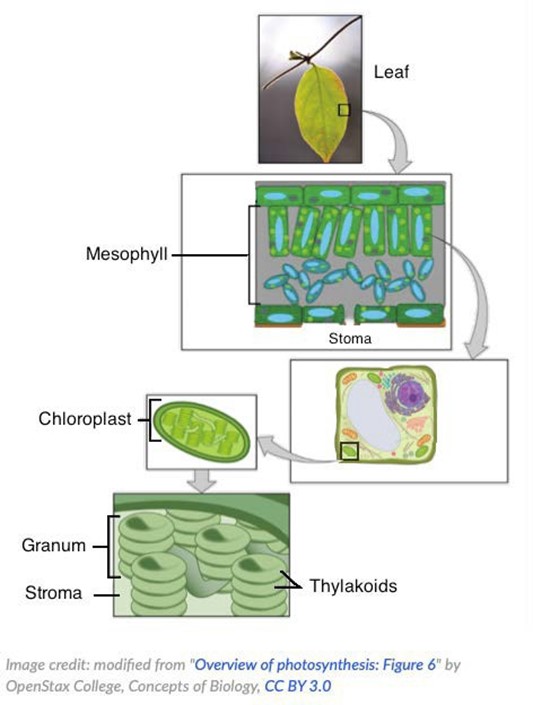
- Students will now research photosynthesis and draw the process as it relates to sweetpotatoes. As students are working, scaffold learning and pose questions that will encourage them to talk about what they see. Encourage them to explain in detail that photosynthesis is the process in which carbon dioxide from the air passes through small holes in the leaves. These pores are called the stomata. Water is absorbed by the roots and passes through the vessels in the stem on its way to the leaves. Photosynthesis takes place in the leaves of plants. The leaves are made of very small cells, called chloroplasts. Each chloroplast contains a green chemical called Chlorophyll is what actually absorbs the sun’s energy. This energy splits water molecules into hydrogen and oxygen. The oxygen is released from the leaves into the atmosphere and the hydrogen and carbon dioxide are used to form glucose (food for the plants).
- Photosynthesis demonstration. This activity can be completed by the teacher or allow students to do this project as partners or small groups. To begin, you will need the following items: a small, clear plastic cup, water, food coloring, and a white paper towel (I recommend Bounty because absorption is key to make this process visible for students). First, fill a small, clear cup with water and add a few drops of food coloring. Allow a moment for the food coloring to mix well with the water; it may have to be stirred a bit. Then take a rope or small piece of paper towel (twisted) and slowly dip into the cup of water. Allow students to watch closely as the paper towel absorbs the water. This is a great visual of how the root system works in plants. Explain to students that sweetpotato plants have shallow, fibrous roots that collect water for plant growth above ground as it grows sweetpotatoes underground.
- Ask students, “Why is photosynthesis important?” Explain to students, “photosynthesis is vital to life on earth, a process that we cannot live without. All of our energy for growth and development comes from eating foods from plants and animals. Animals often eat plants obtaining energy from them and plants obtain energy from glucose made during photosynthesis.”
- Say, “Now let’s look back at the lifecycle of a sweetpotato.” Students will briefly explain the process of photosynthesis, cellular respiration, decomposition, climate change, and the nitrogen cycle and how it supports the growth of sweetpotatoes.
- To understand photosynthesis, we must understand The Carbon Cycle Diagram (see Essential Files)
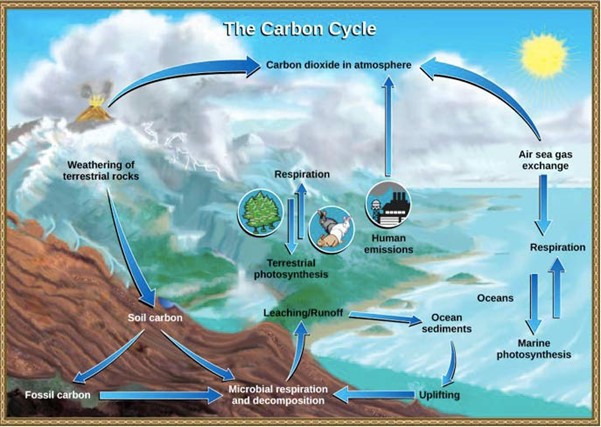
- Extension Activity: To incorporate project-based learning. Divide students into groups – each group will cover a different topic to research and present to the class.
- Research Topics: photosynthesis, cellular respiration, decomposition, climate change, and the nitrogen cycle.
- Allow students to create a visual (poster, power point, etc.) to share different factors that influence the growth and survival of Below are links to videos to get students started:
- Photosynthesis: https://www.khanacademy.org/science/biology/photosynthesis-in- plants/introduction-to-stages-of-photosynthesis/a/intro-to-photosynthesis
- The Calvin Cycle: https://www.khanacademy.org/science/biology/photosynthesis-in- plants/the-calvin-cycle-reactions/a/calvin-cycle
- Cellular Respiration: https://www.khanacademy.org/science/biology/cellular-respiration- and-fermentation/overview-of-cellular-respiration-steps/a/steps-of-cellular-respiration
- Nitrogen Cycle: https://www.khanacademy.org/science/biology/ecology/biogeochemical- cycles/a/the-nitrogen-cycle
Activity 6: Biotechnology & Transgenic Organisms
Objectives Covered: Bio.3.3.3
- During this activity students will understand plant breeding and its purpose in agriculture.
- Students will discuss ethical issues surrounding the use of DNA technology (genetically modified organisms).
- Begin by telling students, “We know that cells are the building blocks of all living things—both plant and animal. They make up all of the systems that carry out important functions that sustain Cells are made up of genes that carry information that determine what living things look like and how they function. All of our genes are made up of DNA that derives from our parents.”
- Tell students: “Scientists and farmers use DNA to their advantage. Did you know that just as genetic traits are in humans, there are genetic traits in plants? Scientists and farmers use these genetic traits for plant breeding.”
- Review plant parts definitions for flower, leaf, and stem. Now ask, “What is plant breeding?” Review definitions listed in the vocabulary section and have students review the reproduction of plants.
- Ask students: “Why do you think plant breeding would be important to the agriculture industry? Reasonable responses would be better plant genetics, higher crop yields, or improving the taste of agricultural commodities such as strawberries or blueberries.
- Next, ask students, “Why do you think sweetpotato farmers would be interested in plant breeding?” Make a list of student responses on the board. Best response would be to increase yields while using natural resources more efficiently or a more generalized answer would be to improve crops and produce new varieties.
- Place students in small groups and give them five minutes to search the internet for examples of plant breeding and report their findings to the whole group. A good example is the work of Norman Borlaug with wheat. As student groups are reporting on their findings make sure they discuss the reasons and benefits for plant breeding and type of
- Inform students that plant breeding techniques are examples of agricultural biotechnology and in the 20th century it became more sophisticated because scientists were learning about genes responsible for desirable For example, scientists can insert a specific gene into a plant seed allowing the plant to grow in special environments or to resist certain insects or weeds that damage plant growth. This is an example of a transgenic organism. A transgenic organism is an organism whose genome has been altered by the transfer of a gene or genes from another species or breed. This is an example of biotechnology.
- Write the word biotechnology on the board or chart paper and dissect the word by explaining to students that “bio” means the study of, and technology means a specialized tool. Agricultural biotechnology is the specialized tool that enhances a breeders’ ability to create crop and livestock improvements.
- Watch the video: What is Biotechnology? Ask students, “Why do we need biotechnology? Why is biotechnology important to agriculture?”
- Correct responses: Biotechnology helps farmers and the environment in many ways for improving harvests and preserving land use while using fewer resources to increase efficiency. The use of biotechnology prevents plants from being damaged by insects and robbed of nutrients by weeds. In protecting plants like corn, soybeans, and cotton from pests, it improves a farmer’s productivity.6 This is very important because the world’s population by year 2050 is predicted to increase to 9.6 billion people, placing our food supply under stress. Farmers will need to produce enough food with fewer resources, such as land, to support our world population.
- Exit ticket: Have students write down another industry other than agriculture they believe biotechnology is used for the enhancement of products. Correct answers are medical, industrial, and environmental. From these responses have students prepare to research different DNA technologies and how they have benefited society.
Activity 7: GMOs, Transgenic Organisms’ Benefits to Society
Objectives Covered: Bio.3.3.2
- During this activity students will discuss ethical issues surrounding the use of DNA technology (genetically modified organisms).
- Students will discuss GMOs.
- Say: “From yesterday’s lesson you presented examples of different ways biotechnology has enhanced products and benefited society.” Say to students “In the case of sweetpotatoes it is the actual root of the plant, known as a tuber or storage root, which scientists desire to improve upon using agricultural biotechnology techniques. However, centuries ago a wild sweetpotato plant “borrowed” a natural bacterial gene from the environment where plants grew larger and stronger to produce a more desirable sweetpotato. This is an example of genetic modification happening in nature and thought to be the world’s first known GMO.7 Today, plant scientists use this example for making similar efforts to adapt desirable traits in new plants, known as genetic The food or crop that a plant produces resulting from agricultural biotechnology is known as a genetic modified organism or GMO.” Preface for students the terms GMO and transgenic organisms can be used interchangeably. Students will understand this in more detail when they complete research later in this activity.
- Use the infographic from GMO Answers called What Is a GMO? to discuss and show students today’s 10 GMO crops commercially available on the market: corn (field & sweet), soy, cotton, alfalfa, sugar beets, canola, papaya, artic apple, potato, and squash.6
- Ask students why they think these crops have been genetically modified. Accept all answers.
- Next identify the following reasons for which the 10 GMOs were created: a.) herbicide tolerance b.) non-browning c.) drought resistance d.) insect resistance e.) disease resistance f.) virus resistance and g.) resist bruising.6 Ask students to work in pairs and match the GM crop to the property for which it was developed and determine the benefit to the farmer and consumer. Answers: Corn (c), Soy (a), Cotton (d), Alfalfa (a), Sugar Beets (a), Canola (a), papaya (f), artic apple (b), potato (g) and Squash (e).
- Research: Provide students with iPads and have them research different transgenic organisms. After researching, allow students time to discuss and report out different ways transgenic organisms have benefited society. During the discussion have students focus on the following information.
- Generalize the applications of transgenic organisms (plants, animals, & bacteria) in agriculture and industry including pharmaceutical applications such as the production of human insulin.
- Summarize the steps in bacterial transformation (insertion of a gene into a bacterial plasmid, getting bacteria to take in the plasmid, selecting the transformed bacteria, and producing the product).
- Opinion Writing: Students will write an opinion piece regarding the benefit of transgenic organisms on society. Students will include their view of GMOs now that they have a better understanding of genetically modified organisms.
Expanding Knowledge
Additional Video: Jake the GMO seed
This video provides students with a better understanding of biotechnology and genetically modified seeds. To deepen their understanding, ask students the following questions, “Who supports and tests GMO seeds and other techniques related to biotechnology? What agencies approve the use of a GMO seed? Does a food crop change in its nutritional value if grown from a GMO seed? What advantages are there for using GMO seeds?”
Concept Elaboration and Evaluation
- What is the difference between a prokaryotic and eukaryotic cell? The main difference between eukaryotic and prokaryotic cells is that eukaryotic cells have a nucleus. The nucleus is where cells store their DNA, which is the genetic material. The nucleus is surrounded by a membrane. Prokaryotic cells do not have a nucleus. Instead, their DNA floats around inside the cell. All prokaryotes are single-celled (unicellular) organisms. Bacteria are prokaryotes. Animals, plants, fungi, and protists are eukaryotes. All multicellular organisms are eukaryotes. A sweetpotato is a made up of eukaryotic cells. To learn more visit: https://www.ck12.org/biology/prokaryotic-and-eukaryotic-cells/lesson/Prokaryotic- and-Eukaryotic-Cells-MS-LS/
- What is the life cycle and cell cycle of a sweetpotato? A sweetpotato vine has a stem, leaves, flowers, and roots like other plants. However, the part of the sweetpotato plant we eat is actually the plant’s storage root, which grows underground. Sweetpotatoes are grown from sprouts to grow more sweetpotatoes. Sweetpotatoes grow under the ground and have green leaves and flowers above the ground. In August, farmers begin to harvest their crop. They use tractors and plows to lift up the soil so the sweetpotatoes can be dug up. After sweetpotatoes are sold to markets the unusable roots are left in the fields to be disked back into the soil to replace lost nutrients. So just how do these plants grow edible roots? The scientific explanation would be the basic components of the plant cell cycle. The plant cell cycle contains a sequence of regulated phases including: G1 phase (postmitotic interphase), S-phase (DNA synthesis occurs), G2 phase (premitotic interphase), and mitosis/cytokinesis. During the G1 stage cells are preparing nuclei for DNA synthesis that occurs in the S-phase. During this phase plant cells know if they will be able to continue cell growth and replication. During the S- phase and gap phases, cells respond to certain factors such as abiotic and biotic stresses. To learn more visit: https://www.khanacademy.org/science/biology/cellular-molecular- biology/mitosis/a/cell-cycle-phases
- How does photosynthesis play an important part of the sweetpotato’s life cycle? Photosynthesis takes place in the leaves of plants. The leaves are made of very small cells, called chloroplasts. Each chloroplast contains a green chemical called chlorophyll. Chlorophyll is what actually absorbs the sun’s energy. This energy splits water molecules into hydrogen and oxygen. The oxygen is released from the leaves into the atmosphere and the hydrogen and carbon dioxide are used to form glucose (food for the plants). This process is important in the growth of not only the leaves and flowers associated with the sweetpotato plant, but also the growth of the sweetpotato. The healthy leaves and flowers are important in gathering the nutrients necessary to grow the tuber root.
- What is agricultural biotechnology? For agriculture, biotechnology has favored crop production in responding to market needs, consumer demands, and environmental changes. With the fast growing population in our world and limited space to produce food, biotechnology practices has given us hope that agriculture can sustain our growing population. Agricultural biotechnology has allowed for purposes such as improving crop yields, to building resistance to diseases, and elimination of certain pests that affect crop production. In sweetpotatoes, biotechnology such as plant breeding techniques has provided new varieties based on desirable genetic traits and improved yields.
- What are GMO crops? Genetically modified organism or GMO is any organism whose genetic material has been altered using genetic engineering. Genetically modified or genetically engineered is a process of using the DNA of one species with DNA of another species to introduce a new trait to the plant which does not occur naturally in the species. Genetic modification can also occur naturally, farmers have been cross breeding plants for many years. GM crops, sometimes referred to as biotech crops are crops that have been altered to withstand weather conditions, pest resistance, and increased production. Take for instance GM crops that have been designed to be pest resistant; drastically reducing the use of pesticides and herbicides applied to the crop reducing the risk to environmental and human health.
Suggested Companion Resources
NC Standard Course of Study
Biology
Bio 1.1 Understand the relationship between the structures and functions of cells and their organelles.
Bio.1.1.1 Summarize the structure and function of organelles in eukaryotic cells (including the nucleus, plasma membrane, cell wall, mitochondria, vacuoles, chloroplasts, and ribosomes) and ways that these organelles interact with each other to perform the function of the cell.
Bio.1.1.2 Compare prokaryotic and eukaryotic cells in terms of their general structures (plasma membrane and genetic material) and degree of complexity.
Bio.1.2 Analyze the cell as a living system.
Bio.1.2.1 Explain how homeostasis is maintained in a cell and within an organism in various environments (including temperature and pH).
Bio.1.2.2 Analyze how cells grow and reproduce in terms of interphase, mitosis and cytokinesis.
Bio. 2.1 Analyze the interdependence of living organisms within their environments.
Bio.2.1.1 Analyze the flow of energy and cycling of matter (such as water, carbon, nitrogen and oxygen) through ecosystems relating the significance of each to maintaining the health and sustainability of an ecosystem.
Bio.3.3.2 Summarize how transgenic organisms are engineered to benefit society.
Bio.3.3.3 Evaluate some of the ethical issues surrounding the use of DNA technology (including cloning, genetically modified organisms, stem cell research, and Human Genome Project).
National Agricultural Literacy Outcomes
Agriculture and the Environment
- (b) Describe resource and conservation management practices used in agricultural systems (e.g., riparian management, rotational grazing, no till farming, crop and variety selection, wildlife management, timber harvesting techniques)
- (e) Evaluate the potential impacts of climate change on agriculture
- (h) Understand the natural cycles that govern the flow of nutrients as well as the way various nutrients (organic and inorganic) move through and affect farming and natural systems
Plant, Animals, Food, Fiber, and Energy
- (d) Evaluate evidence for differing points of view on topics related to agricultural production, processing, and marketing (e.g., grazing; genetic variation and crop production; use of fertilizers and pesticides; open space; farmland preservation; animal welfare practices; world hunger)
Food, Health, and Lifestyle Outcomes
- (g) Identify how various foods can contribute to a healthy diet
Science, Technology, Engineering & Mathematics
- (c) Discuss population growth and the benefits and concerns related to science and technologies applied in agriculture to increase yields and maintain sustainability
- (d) Evaluate the benefits and concerns related to the application of technology to agricultural systems (e.g., biotechnology)
- (e) Identify current and emerging scientific discoveries and technologies and their possible use in agriculture (e.g., biotechnology, bio-chemical, mechanical, )
Culture, Society, Economy & Geography
- (e) Discuss how agricultural practices have increased agricultural productivity and have impacted (pro and con) the development of the global economy, population, and sustainability
Sources and Credits
- https://statesymbolsusa.org/symbol-official-item/north-carolina/state-food-agriculture- symbol/sweet-potato
- https://archive.org/stream/sweetpotatocultu00pric#page/12/mode/2up
- https://www.loc.gov/rr/scitech/mysteries/sweetpotato.html
- https://ncsweetpotatoes.com/sweet-potatoes-101/how-to-grow-sweet-potatoes/
- https://demography.cpc.unc.edu/2017/11/17/nc-in-focus-sweet-potatoes-2017/
- https://gmoanswers.com/
- https://www.sciencedaily.com/releases/2015/04/150421084204.htm
- https://www.nass.usda.gov/Statistics_by_State/North_Carolina/Publications/County_Estimates/SweetPota pdf
- https://cipotato.org/research/sweet-potato/sweetpotato-one-word-or-two/
This publication was supported by the U.S. Department of Agriculture’s (USDA) Agricultural Marketing Service through grant 17-182-2001. Its contents are solely the responsibility of the authors and do not necessarily represent the official views of the USDA.
